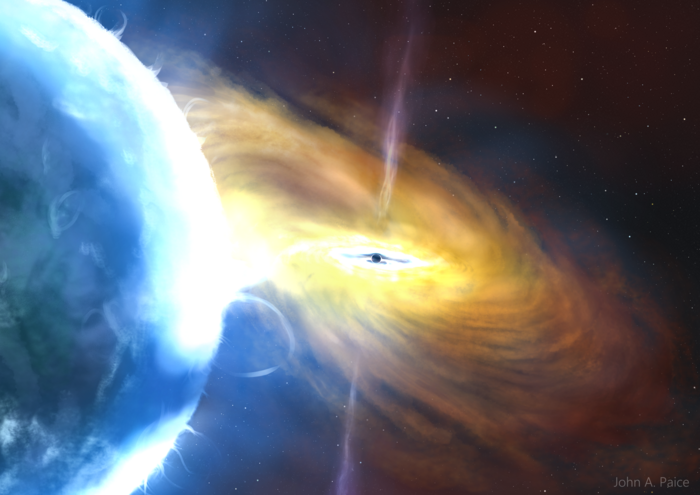
Largest known cosmic explosion has been visible for three years
A team of astronomers led by the University of Southampton in the UK has recently uncovered the largest cosmic explosion ever observed. This explosion, known as AT2021lwx, was first detected in 2020 by the Zwicky Transient Facility in California, and soon after picked up by the Asteroid Terrestrial-impact Last Alert System (ATLAS) based in Hawaii.
It is over ten times brighter than any previously-known supernova, and three times brighter than the brightest tidal disruption event, in which a star is swallowed by a supermassive black hole.
Moreover, by contrast to most supernovae, which only remain visible for a few months, AT2021lwx has been visible for over three years. It occurred nearly eight billion light years away, when the universe was approximately six billion years old, and is still being monitored by a network of telescopes.
“We came upon this by chance, as it was flagged by our search algorithm when we were searching for a type of supernova,” said study lead author Philip Wiseman, a research fellow in Astronomy at Southampton. “Most supernovae and tidal disruption events only last for a couple of months before fading away. For something to be bright for two plus years was immediately very unusual.”
The scientists managed to determine the distance to the object by examining the spectrum of the light, separating it into various wavelengths, and measuring the different absorption and emission characteristics of the spectrum.
“Once you know the distance to the object and how bright it appears to us, you can calculate the brightness of the object at its source. Once we’d performed those calculations, we realized this is extremely bright,” reported co-author Sebastian Hönig, a professor of Observational and Computational Astrophysics at Southampton.
Although quasars – supermassive black holes with a constant flow of gases falling onto them at high velocity – are as bright as AT2021lwx, their brightness is usually flickering up and down over time, a feature not noticed in the case of this explosion.
The experts believe that AT2021lwx was likely caused by a vast cloud of gas, possibly thousands of times larger than our sun, which has been violently disrupted by a supermassive black hole. The fragments of this cloud would have been engulfed, causing shockwaves to ripple through the remaining pieces and even into a vast dusty “doughnut” encircling the black hole. Such incidents are highly infrequent, and nothing of this magnitude has ever been witnessed before.
“With new facilities, like the Vera Rubin Observatory’s Legacy Survey of Space and Time, coming online in the next few years, we are hoping to discover more events like this and learn more about them. It could be that these events, although extremely rare, are so energetic that they are key processes to how the centers of galaxies change over time,” Wiseman concluded.
The study is published in the journal Monthly Notices of the Royal Astronomical Society.
What is a cosmic explosion?
A cosmic explosion refers to a violent release of energy in the universe, often resulting in a bright, often transient event. These explosions can happen for various reasons and in different scales.
Examples of cosmic explosions:
Supernova
This is an explosion of a star at the end of its lifecycle. When a star has consumed all its fuel, it can collapse under its own gravity, causing a massive explosion. This releases a significant amount of energy and light, and it can outshine an entire galaxy for a short period of time.
Gamma-ray Burst (GRB)
These are the brightest and most energetic events known in the universe. They are thought to be caused by the collapse of massive stars or by the merging of neutron stars or a neutron star and a black hole. The energy is focused into two jets that shoot out in opposite directions, and if one of these jets is pointed toward Earth, we can detect it as a gamma-ray burst.
Big Bang
This is the cosmological model of the initial conditions of the universe, which describes a very hot and dense state followed by expansion. While not an “explosion” in the traditional sense, it’s often described that way because of the rapid expansion and high energy state.
Stellar Flare
Stars, including our Sun, can release flares or coronal mass ejections, which are sudden, intense increases in brightness due to magnetic activity. These are smaller than supernovae or gamma-ray bursts, but still can have significant effects, particularly if they occur in our own solar system.
Quasar
Quasars are extremely luminous active galactic nuclei, powered by accretion of material onto supermassive black holes in the centers of distant galaxies. Jets and radiation from quasars can outshine their host galaxies.
Note that these are all very different processes, with different causes and effects. However, they all involve a large release of energy and are often visible across vast distances.
Image Credit: John A. Paice www.johnapaice.com/
—
By Andrei Ionescu, Earth.com Staff Writer
Check us out on EarthSnap, a free app brought to you by Eric Ralls and Earth.com.













